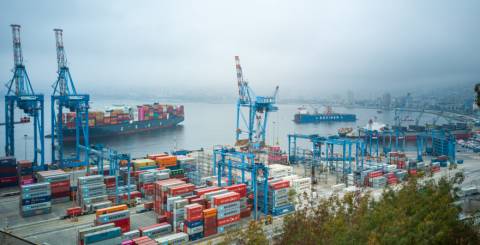Supply Chain Management and Logistics: Key Benefits of IoT

The Internet of Things (IoT) has revolutionized various industries, including supply chain and logistics. Integrating IoT devices, such as sensors and radio-frequency identification (RFID) tags, has provided real-time tracking and monitoring capabilities throughout the supply chain process. It allows for better visibility and control of inventory, assets, and shipments. IoT technology also enables predictive maintenance, reducing downtime and improving overall efficiency. Additionally, data collected from IoT devices can be analyzed to identify patterns and optimize the supply chain process.
The Internet of Things (IoT) has revolutionized managing and monitoring supply chain and logistics operations. Here are some of the benefits IoT brings to supply chain management and logistics:
- Real-time monitoring and tracking: IoT sensors and devices can be used to monitor the location, temperature, humidity, and other environmental factors of goods in transit. It enables logistics managers to track the movement of goods in real time and adjust shipping routes or storage conditions as needed.
- Predictive maintenance: IoT sensors monitor the condition of vehicles, machinery, and other equipment used in logistics operations. This data can be used to predict when care is needed, preventing breakdowns and reducing downtime.
- Improved inventory management: IoT sensors can track inventory levels in real-time, enabling logistics managers to optimize them and reduce the risk of stockouts or overstocks.
- Enhanced security: IoT sensors can monitor cargo containers and trucks, providing real-time alerts if there is any unauthorized access or tampering.
- Improved customer service: IoT sensors can provide customers with real-time updates on the status of their orders, including expected delivery times and any delays.
- Cost savings: By optimizing logistics operations and reducing downtime, IoT can help reduce costs associated with transportation, maintenance, and inventory management.
Overall, integrating IoT in supply chain and logistics can increase transparency, reduce costs, and improve customer satisfaction. Now, allow us to offer you a closer look at the immense potential of IoT for the supply chain and logistics sector:
- Improve efficiency: Incorporating IoT technology in the supply chain allows companies to simplify various tasks, such as locating goods and tracking the movement of raw and finished goods. The technology can also determine transit delays, devise alternate routes, estimate arrival times at specific destinations, and more. IoT in logistics and supply chain management also provides advantages such as improved segmentation, enhanced inventory control, and automated processes. All these abilities, then, ensure enhanced efficiency of supply chain operations.
- Better transparency in inventory management: Inventory management is rendered more transparent and precise with the integration of IoT, as it enables companies to access real-time information about the location and status of every asset, raw material, and finished good. Companies can use this data to monitor and optimize inventory levels in real-time, check inventory status, make informed business decisions, prevent product shortages, and so much more.
- Improved monitoring of storage conditions: IoT technology has also enabled the integration of environmental sensors in logistics, thus allowing companies to track cargo conditions and quickly respond to changes. For example, an IoT-based supply chain system will be able to collate data about pressure, humidity, and temperature inside fleet vehicles — i.e., variables that could compromise the quality of goods — and adjust the environment to maintain the integrity of the products being transported.
- Automation: Today, organizations have come to rely on automation to help minimize the amount of physical labor needed as well as reduce labor costs, mitigate the risk of human error, and accelerate deliveries. With IoT, the supply chain sector has implemented necessary automation in processes. IoT systems are now also using drones to manage warehouses.
Undoubtedly, the idea of integrating advanced technologies, especially one as seemingly complex as the Internet of Things, may seem a tad overwhelming at the outset. Thankfully, as the discussion above demonstrates, the many advantages that the Internet of Things (IoT) brings to the table for the supply chain and logistics industry make it well worth the effort and investment. From substantially improved inventory management to the ability to keep an eye on the operations, including the fleet, in real-time — there is so much that the Internet of Things stands to do for this sector in particular. So, what are you waiting for? Go ahead and start looking for an expert IoT app development services vendor and immediately integrate this technology into your supply chain and logistics operations.
Similar Articles
Decentralized Finance (DeFi) has transformed how users earn passive income through blockchain-based financial systems. Among its most popular use cases,
Staying organized can feel like a full-time job. Between meetings, deadlines, and personal commitments, it’s easy to get overwhelmed.
Choosing the right GIS mapping software depends on what you need to accomplish. Some platforms cater to developers who want to build custom applications from scratch.
For data intensive industries such as insurance, the global business landscape is undergoing a profound transformation. Thanks to all the relentless technological innovation, this shift presents both significant challenges and unparalleled opportunities for modernization of the insurance sector.
Organizations are always looking for newer technologies to aid their operations. So, this hunt revolves around solutions that offer not only agility and scalability but are also cost-effective.
Not long ago, the idea of multiple AI agents working together, each with a specific role, collaborating to solve problems, felt like science fiction.
In today’s data-driven world, choosing the right business intelligence (BI) platform can make or break your organization's analytics success.
We all know that companies today are no longer limited to a single physical location. Work processes are also no longer strictly isolated.
It is neither secret nor news that the mind-boggling pace of digital transformation around us has totally altered consumer expectations.









